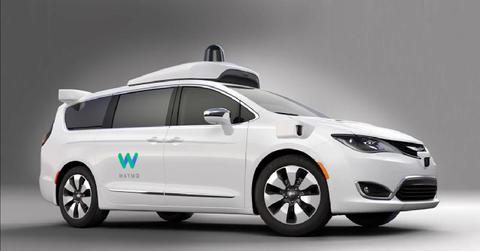Google's 'Waymo' Embraces Fully Self-Driving Cars
Waymo's goal has been to make fully self-driving cars, and now they've made it official that they won't add any human input while their vehicles are on the go. It's a big contrast to other automakers that are focused on autopilot features.
Updated May 22 2019, 12:14 a.m. ET
When it comes to self-driving cars, many people still want the chance to take control of their vehicle if the occasion calls for it, such as during an emergency. Some automakers are working on the technology that would allow users to do just that. Google, however, has made an interesting discovery: In testing their self-driving cars, they realized that human drivers were falling asleep at the wheel and slow to respond in such emergencies, when the system alerted them to take over. With this realization, they're moving into technology that requires no human intervention at all.
John Krafcik, CEO of Waymo, announced on Monday that the company officially wouldn’t add any autopilot features in their vehicles. Tests were filmed back in 2013 of employees on their phones, sleeping, and doing various other activities when the car was driving at nearly 60 miles per hour. These videos were finally released at a public event on Monday.
The problem arises in a system where the car alerts the passenger to take control of the vehicle. Waymo believes that it would be a dangerous situation for somebody to break out of what they’re doing and attempt to control the vehicle. Understandably, if they weren't paying attention to begin with, it can be confusing and startling for someone to jump in and figure out what to do.
Waymo’s goal has always been to produce a fully autonomous vehicle, but their intentions are now official this week. Prototypes they’ve released have always shown the interior without a steering wheel. Other automakers dabbling into the self-driving industry have been focused on creating “Level 4” autonomous driving, meaning that the car will mostly drive with minimal human input.
There is some input that passengers can give, although it doesn’t effect the driving. In the Chrysler Pacifica minivan, there’s a button to start the ride and there’s an ability to ask the vehicle to pull over at the next convenient location. Phoenix, Arizona, is currently home to numerous Waymo testing vehicles that provide a ride-hailing service. These vehicles are limited to certain routes that the company has deemed completely safe.
Google’s self-driving division has a lot of work ahead of them in order for vehicles to become fully autonomous, which is “Level 5.” Perhaps the biggest obstacle is gaining public trust in autonomy. Many are willing to embrace the new technology, but there’s even more that remain skeptical of a computer running the entire show. If the vehicle runs into a situation it can’t resolve, such as street light malfunctions or an immediate accident, how would it react?
“I think one of the reasons for [these complications] is because all of the folks playing in the [Level 4] space right now have drivers in the driver seat,” Krafcik told The Verge. “It doesn’t feel like fully self driving. When you drive on public roads, you have someone in the driver's seat. Sometimes it’s part of the law, or they’re doing it because it’s just the safe thing to do.”
Having zero interaction with driving is going to be a hard sell for those that don’t want to give up the ability entirely. In an ideal world, every vehicle would be fully autonomous. Even though accidents would still crop up as computers can and will malfunction, safety percentages would rise with the removal of human error. It’ll be interesting to see how Google’s stance affects the self-driving industry.
